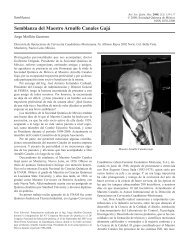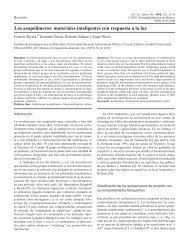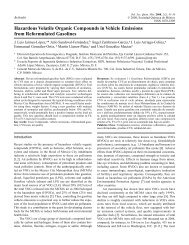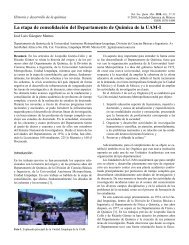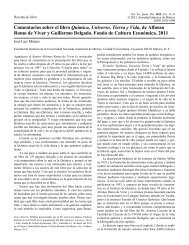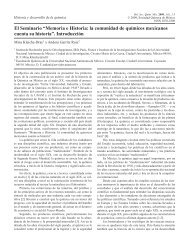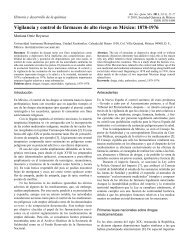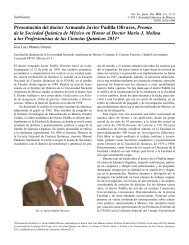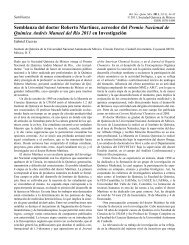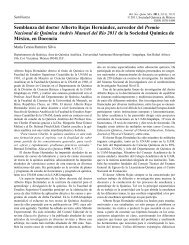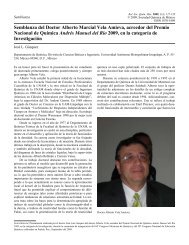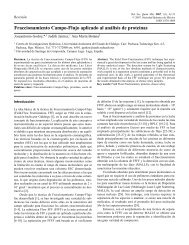A New Generalized Matrix Inverse Method for Balancing Chemical ...
A New Generalized Matrix Inverse Method for Balancing Chemical ...
A New Generalized Matrix Inverse Method for Balancing Chemical ...
Create successful ePaper yourself
Turn your PDF publications into a flip-book with our unique Google optimized e-Paper software.
A <strong>New</strong> <strong>Generalized</strong> <strong>Matrix</strong> <strong>Inverse</strong> <strong>Method</strong> <strong>for</strong> <strong>Balancing</strong> <strong>Chemical</strong> Equations and their Stability 105<br />
Now, shortly we will describe these views.<br />
• Jones <strong>for</strong> the first time in mathematics proposed the<br />
general problem <strong>for</strong> balancing chemical equations<br />
[1]. Actually he <strong>for</strong>malized century old problem in a<br />
compact linear operator <strong>for</strong>m as a Diophantine matrix<br />
equation. This problem was not solved 36 years. After<br />
that, Krishnamurthy [2] gave a mathematical method<br />
<strong>for</strong> balancing chemical equations founded by virtue of<br />
a generalized matrix inverse. He considered some elementary<br />
chemical equations, which were well known in<br />
chemistry since long time. Little bit late Das [3] offered<br />
a simple mathematical method, which was discussed in<br />
[4, 5]. A computer model <strong>for</strong> balancing some elementary<br />
chemical equations over an integer programming<br />
approach is given in [6]. Finally, in [7] by using of a<br />
reflexive g-inverse matrix is solved the general problem<br />
of balancing chemical equations proposed in [1]. Other<br />
mathematical results <strong>for</strong> balancing chemical equations<br />
and their stability over a nonsingular matrix method are<br />
obtained in [8]. The most general results <strong>for</strong> balancing<br />
chemical equations over a Moore-Penrose pseudoinverse<br />
matrix are obtained in [9]. In [10] is balanced a new<br />
class of chemical equations which reduces to a square<br />
n×n matrix. The solution of this class of chemical<br />
equation is founded by virtue of Drazin pseudoinverse<br />
matrix. Actually, to date in mathematics and chemistry<br />
there are only five strictly <strong>for</strong>malized consistent mathematical<br />
methods <strong>for</strong> balancing chemical equations,<br />
particularly they are methods given in [7, 8, 9, 10] and<br />
right now presented method in this work, while other so<br />
called methods in chemical sense have limited usage,<br />
and they are useful only <strong>for</strong> particular cases, especially<br />
<strong>for</strong> balancing chemical equations which possess atoms<br />
with integer oxidation numbers.<br />
• There are many published articles in chemistry [11-31],<br />
which consider the use of computers to balancing chemical<br />
equations. All of these computational methods<br />
use some commercial softer packet, but un<strong>for</strong>tunately<br />
no one of them not deal with fractional oxidation<br />
numbers. Just that, it is one of their biggest weaknesses,<br />
which limit them to be applicable only in some<br />
particular cases and nothing more. It is of interest to<br />
emphasis here that same holds <strong>for</strong> the current online<br />
methods available on internet which employ only integer<br />
oxidation numbers. So, to date we do not know any<br />
computer method <strong>for</strong> balancing chemical equations<br />
to deal with fractional oxidation numbers, except previously<br />
mentioned methods of the author of this work.<br />
Actually, it was the main motive <strong>for</strong> the author to direct<br />
his research <strong>for</strong> development of new mathematical<br />
methods <strong>for</strong> balancing chemical equations in Q (the<br />
set of rational numbers of <strong>for</strong>m p/q) in such a way to<br />
extend and generalize the current particular techniques<br />
used in chemistry right now <strong>for</strong> balancing only chemical<br />
equations in N (the set of natural numbers).<br />
• University textbooks of general chemistry generally<br />
support the ion-electron technique as basic procedure<br />
<strong>for</strong> balancing chemical equation, because it makes the<br />
best use of fundamental chemical principles. Also,<br />
some authors advocated other techniques which involve<br />
less algebraic manipulation that may deserve attention<br />
– particularly in classes of chemistry and chemical<br />
engineering majors [32-58].<br />
Several simple chemical equations are solved by elementary<br />
algebraic techniques in [47, 59-64]. The earliest<br />
article that makes use of the linear algebra method<br />
was published by Bottomley [65]. A set of various<br />
modifications which implement this approach is documented<br />
in [33, 46, 47, 66-68]. The case when the<br />
chemical equation has no unique solution received<br />
considerable attention in the education articles [20,<br />
69-79]. The equation represents two or more independently<br />
occurring reactions can be combined in varying<br />
stoichiometric ratios [80, 81]. Fixed ratios of reagents,<br />
observed experimentally in particular cases, are equivalent<br />
to a restriction on the coefficients that make a<br />
unique solution [20].<br />
It is necessary to emphasis that balancing chemical<br />
equations by inspection is equivalent to using the<br />
algebraic method or a computerized matrix algebra<br />
approach [82, 83]. The valence change method [32,<br />
84-106] and the ion-electron method [83-88, 92, 101,<br />
107-113] are also simple algebraic inspection techniques,<br />
subjected to exactly the same controls and<br />
limitations as the algebraic and matrix methods. Here<br />
it is good to emphasis that first Karslake in [114]<br />
considered balancing of ionic chemical equations.<br />
Actually, the technique suggested by García [115]<br />
can reduces the number of algebraic steps <strong>for</strong> ionelectron<br />
method. Previous both mentioned methods<br />
- the valence change method and ion-electron method<br />
begin by establishing the relative proportions of reagents<br />
taking part in separate oxidation and reduction<br />
components of a redox reaction. Then, each technique<br />
uses a lowest common multiplier to en<strong>for</strong>ce a principle<br />
of conservancy - <strong>for</strong> instance, conservation of<br />
oxidation number change in the case of the oxidation<br />
number method. Johnson in his article [116] defined<br />
the equivalent term oxidation stage change on this<br />
subject.<br />
Stout in [117] presented three redox reactions as<br />
puzzles. Each one can be shown as simple redox system,<br />
which may easily be balanced using here offered<br />
method. After this article was published, the followed<br />
other debatable articles with critical accent [118-123].<br />
• <strong>Balancing</strong> chemical equations through the pedagogical<br />
point of view is given in the articles [112, 124-131].<br />
This approach is very interesting <strong>for</strong> the education of<br />
chemical research. A check of the hypothesis that <strong>for</strong>mal<br />
reasoning and a sufficiently large mental capacity<br />
are required to balance more complex many-step equa-



